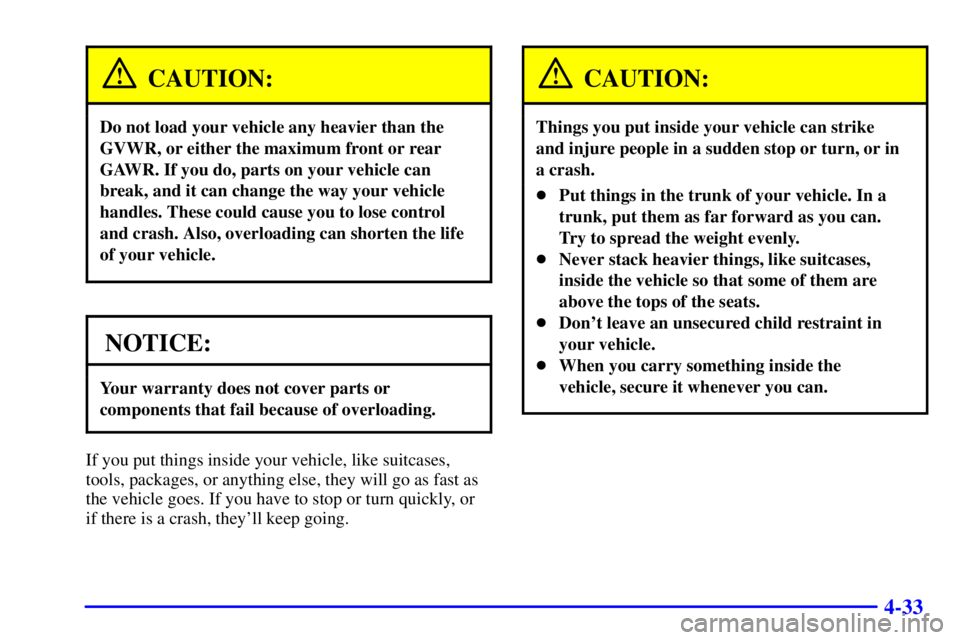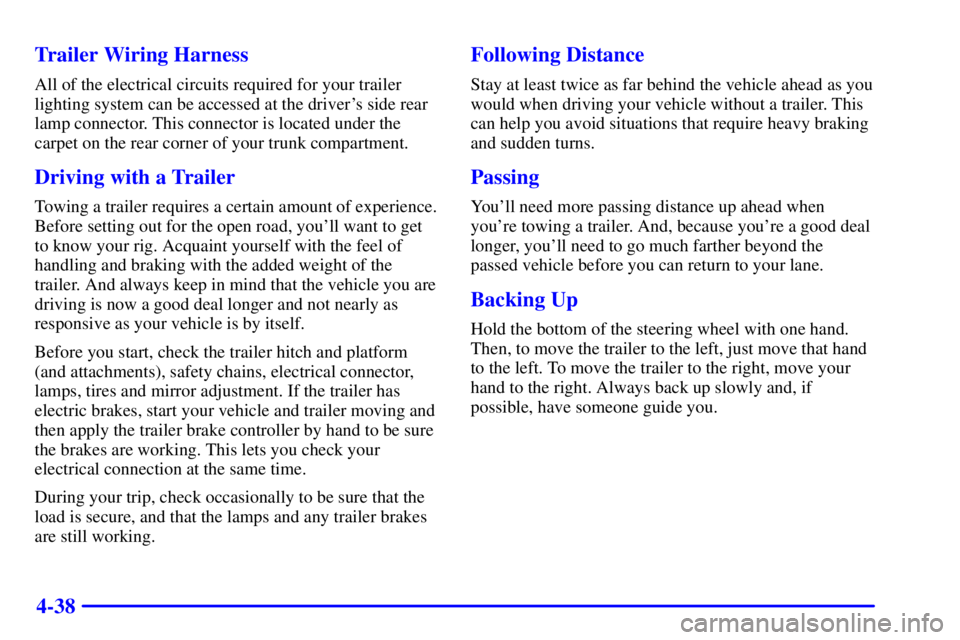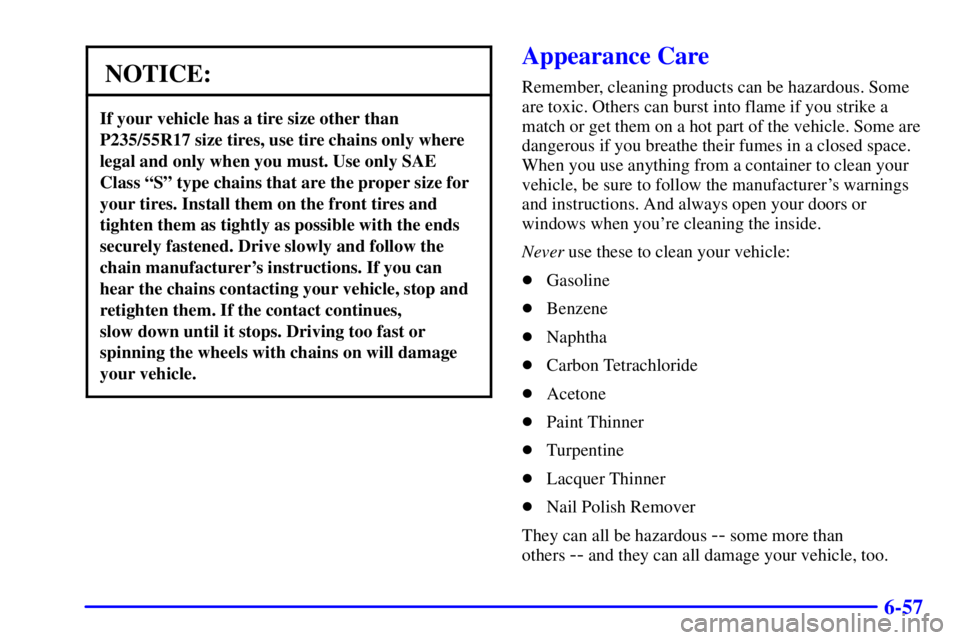Page 248 of 427
4-26
Winter Driving
Here are some tips for winter driving:
�Have your vehicle in good shape for winter.
�You may want to put winter emergency supplies in
your trunk.
Include an ice scraper, a small brush or broom, a supply
of windshield washer fluid, a rag, some winter outer
clothing, a small shovel, a flashlight, a red cloth and a
couple of reflective warning triangles. And, if you will
be driving under severe conditions, include a small bag
of sand, a piece of old carpet or a couple of burlap bags
to help provide traction. Be sure you properly secure
these items in your vehicle.
Page 255 of 427

4-33
CAUTION:
Do not load your vehicle any heavier than the
GVWR, or either the maximum front or rear
GAWR. If you do, parts on your vehicle can
break, and it can change the way your vehicle
handles. These could cause you to lose control
and crash. Also, overloading can shorten the life
of your vehicle.
NOTICE:
Your warranty does not cover parts or
components that fail because of overloading.
If you put things inside your vehicle, like suitcases,
tools, packages, or anything else, they will go as fast as
the vehicle goes. If you have to stop or turn quickly, or
if there is a crash, they'll keep going.
CAUTION:
Things you put inside your vehicle can strike
and injure people in a sudden stop or turn, or in
a crash.
�Put things in the trunk of your vehicle. In a
trunk, put them as far forward as you can.
Try to spread the weight evenly.
�Never stack heavier things, like suitcases,
inside the vehicle so that some of them are
above the tops of the seats.
�Don't leave an unsecured child restraint in
your vehicle.
�When you carry something inside the
vehicle, secure it whenever you can.
Page 260 of 427

4-38 Trailer Wiring Harness
All of the electrical circuits required for your trailer
lighting system can be accessed at the driver's side rear
lamp connector. This connector is located under the
carpet on the rear corner of your trunk compartment.
Driving with a Trailer
Towing a trailer requires a certain amount of experience.
Before setting out for the open road, you'll want to get
to know your rig. Acquaint yourself with the feel of
handling and braking with the added weight of the
trailer. And always keep in mind that the vehicle you are
driving is now a good deal longer and not nearly as
responsive as your vehicle is by itself.
Before you start, check the trailer hitch and platform
(and attachments), safety chains, electrical connector,
lamps, tires and mirror adjustment. If the trailer has
electric brakes, start your vehicle and trailer moving and
then apply the trailer brake controller by hand to be sure
the brakes are working. This lets you check your
electrical connection at the same time.
During your trip, check occasionally to be sure that the
load is secure, and that the lamps and any trailer brakes
are still working.
Following Distance
Stay at least twice as far behind the vehicle ahead as you
would when driving your vehicle without a trailer. This
can help you avoid situations that require heavy braking
and sudden turns.
Passing
You'll need more passing distance up ahead when
you're towing a trailer. And, because you're a good deal
longer, you'll need to go much farther beyond the
passed vehicle before you can return to your lane.
Backing Up
Hold the bottom of the steering wheel with one hand.
Then, to move the trailer to the left, just move that hand
to the left. To move the trailer to the right, move your
hand to the right. Always back up slowly and, if
possible, have someone guide you.
Page 330 of 427
6-35
To be sure the vent hose (A) is properly attached, the
vent hose connectors (B) must be securely reattached
to the vent outlets (C) on each side of the battery, and
the vent assembly grommet (D) must be secured to the
floor pan (E).
Vehicle Storage
If you're not going to drive your vehicle for 25 days
or more, remove the black, negative (
-) cable from
the battery. This will help keep your battery from
running down.
CAUTION:
Batteries have acid that can burn you and gas
that can explode. You can be badly hurt if you
aren't careful. See ªJump Startingº in the Index
for tips on working around a battery without
getting hurt.
Contact your dealer to learn how to prepare your vehicle
for longer storage periods.
Also, for your audio system, see ªTheft
-Deterrent
Featureº in the Index.
Page 338 of 427
6-43
4. Tip the headlamp assembly and while pressing the
release, turn the bulb and socket counterclockwise to
remove them.
5. Replace the bulb and reinstall the socket. Then
reconnect the wiring harness to the lamp assembly.6. Slide the lamp assembly back into place by lining up
the track on the bottom of the assembly with the
guide on the vehicle. Then connect the outboard snap
and secure the lamp assembly with the two bolts.
Page 352 of 427

6-57
NOTICE:
If your vehicle has a tire size other than
P235/55R17 size tires, use tire chains only where
legal and only when you must. Use only SAE
Class ªSº type chains that are the proper size for
your tires. Install them on the front tires and
tighten them as tightly as possible with the ends
securely fastened. Drive slowly and follow the
chain manufacturer's instructions. If you can
hear the chains contacting your vehicle, stop and
retighten them. If the contact continues,
slow down until it stops. Driving too fast or
spinning the wheels with chains on will damage
your vehicle.
Appearance Care
Remember, cleaning products can be hazardous. Some
are toxic. Others can burst into flame if you strike a
match or get them on a hot part of the vehicle. Some are
dangerous if you breathe their fumes in a closed space.
When you use anything from a container to clean your
vehicle, be sure to follow the manufacturer's warnings
and instructions. And always open your doors or
windows when you're cleaning the inside.
Never use these to clean your vehicle:
�Gasoline
�Benzene
�Naphtha
�Carbon Tetrachloride
�Acetone
�Paint Thinner
�Turpentine
�Lacquer Thinner
�Nail Polish Remover
They can all be hazardous
-- some more than
others
-- and they can all damage your vehicle, too.
Page 368 of 427
6-73
2. Slide the rear of the cushion up and under the
seatback so the rear locating guides hook into the
wire loops on the back frame.
3. With the seat cushion lowered, push rearward and
then press down on the seat cushion until the spring
locks on both ends engage.
4. Check to make sure the safety belts are properly
routed and that no portion of any safety belt is
trapped under the seat. Also make sure the seat
cushion is secured.Rear Underseat Fuse Block
The rear fuse block is
located below the rear
seat on the driver's side.
The rear seat cushion must
be removed to access the
fuse block. See ªRemoving
the Rear Seat Cushionº in
the Index.
Page 417 of 427

8-2
Pontiac Cares
With PONTIAC CARES, you are never more than
a phone call away from having your concern taken
care of.The PONTIAC CARES philosophy and elements are
designed to make you realize that Pontiac recognizes
you as a valuable customer, appreciates your purchase
decision, and is dedicated to taking care of the most
important person ... YOU! PONTIAC CARES is:
A valuable feature that comes with every Pontiac,
a feature that offers a multitude of benefits that can
give you safety, security, comfort and convenience.
What Makes Up Pontiac Cares?
�A 3 year/36,000 mile (60 000 km)
Bumper
-to-Bumper Warranty
�Customer Assistance
�Roadside Assistance
�Courtesy Transportation
All of these elements combine to make your driving
experience an enjoyable one and are discussed in greater
detail in your owner's manual. Pontiac is focusing on
the changing needs of our customers and is committed
to giving you an exceptional level of customer care
throughout your ownership experience. Our goal is
to create total customer enthusiasm in our product and
our services and make you the most satisfied customer
in the world.